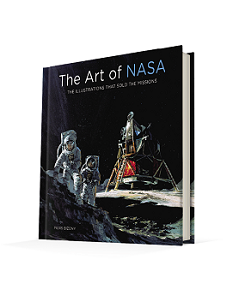The use of artist’s illustrations is widespread in the space business, and always has been, mainly because it’s not that easy to pop out with a camera and take a snap of a space mission. Moreover, even before plans have been approved and hardware has been built, there has always been a need to ‘sell’ a concept, either to the tax-paying public or a commercial customer.
This book chronicles the art used by NASA to sell the space programme to the American public and, beyond that, to enthuse the rest of the world with the Agency’s plans to explore the solar system. Although the cover features an image from the Apollo era, this represents only part of the book’s coverage. Five chapters illustrate how NASA showcased its plans for the early years of the Space Age; Apollo itself; orbital missions (including shuttles and space stations); future Moon-Mars exploration; and the “depths of space beyond Mars”. This large format (30 x 30 cm) hardback has a small but useful index which, quite correctly, includes the names of the artists.
The paper and print quality is of a high standard and the semi-matt finish makes viewing the images a comfortable experience. It’s not just about the images though, and author Piers Bizony uses his considerable experience to place the pictures in their historical perspective. For example, younger readers should note the fact that, in the early days of the Space Age, most televisions and newspapers were ‘black and white’, with colour reproduction largely confined to high-end magazines. Those with a knowledge of space history will be aware, for example, of Collier’s space-themed articles of the 1950s, illustrated by Chesley Bonestell, and Life magazine’s photographic ‘astronaut features’ of the 1960s.
As a reviewer well-versed in space-related illustrations, one sees a large number of familiar depictions of the Space Age, but so much effort was put into the field that there is always something new to discover. As an engineer, I appreciate artworks with a level of technical detail (and will always be a fan of Bob McCall), but there is also beauty in the innocence of some of the earlier works (which, after all, were based more on imagination than actual hardware). A rendering of an astronaut with spanners, a screwdriver and a torch in what appears to be leather tool-belt has a certain charm.
Interestingly, more than six decades into the Space Age, we still rely on artists to show us what spacecraft flying by Jupiter might look like, let alone the concepts for space colonies and starships. This is not a book on ‘space art’ per se, and readers will need to look elsewhere for the more expressionist works, but its insight into NASA’s use of artistic talent provides a fascinating deviation from the day-to-day grind.











